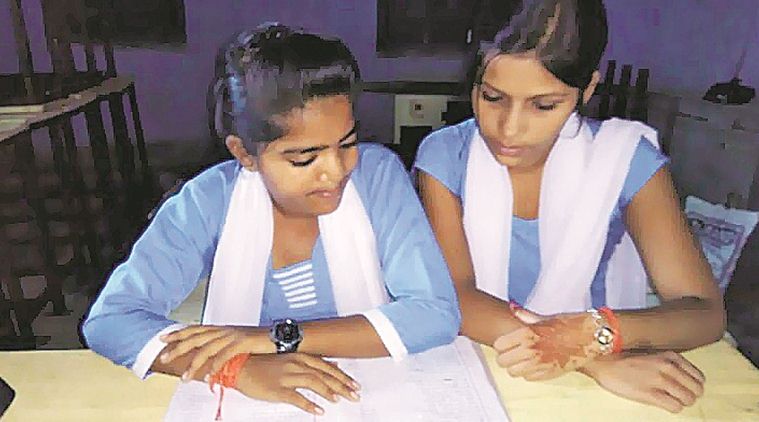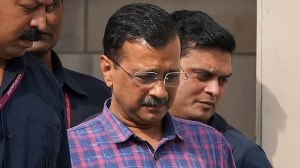- India
- International
From five schools to 143, TV time for Banka’s children means notebooks & smart classes
The Katoria school holds these smart classes as part of ‘Banka Unnayan’, a programme introduced last August in five schools for Class 10 students and which has now been expanded to all 143 senior secondary government schools in the district.
 Lakshmi Kumari (left) and Nisha Kumari of Project Girls High School in Katoria use the Unnayan app. (Photo: Santosh Singh)
Lakshmi Kumari (left) and Nisha Kumari of Project Girls High School in Katoria use the Unnayan app. (Photo: Santosh Singh)
It is 11 am, time for “TV serial-type” lessons inside the Project Girls High School at Katoria in Bihar’s Banka district. Around 85 students of Class 10 are crammed in a room, four girls to a bench, but no one’s complaining. On a 40-inch screen plays a video, in Hindi, on photosynthesis. The nodal teacher, Manoj Kumar Choubey, pauses the video at intervals to explain finer points before moving on. At the end of 10 minutes, Choubey asks, “Koi sawaal (Any questions)?” and a few hands go up.
The Katoria school holds these smart classes as part of ‘Banka Unnayan’, a programme introduced last August in five schools for Class 10 students and which has now been expanded to all 143 senior secondary government schools in the district. Since August this year, the programme has been expanded to Class 9 as well.
As classrooms across the country employ smart lessons and mobile phone-based learning, what makes this experiment unique are the challenges. Banka, a Maoist-hit tribal district in south-eastern Bihar, has a dismal literacy rate of 58.17 per cent, far below the national average of 74.04 per cent. Most government schools in the district are run-down structures with few classrooms and fewer teachers. But some of these schools have a computer room and that’s where the project began taking shape.
Conceived by Banka District Magistrate Kundan Kumar and Eckovation, a mobile-based social learning platform set up by a group of IIT graduates, the project involves integrating technology-based learning with continuous monitoring of the students through a centralised tracking system, which prepares a digital report card for each student.
“I had experimented with a similar programme in Nalanda, where I was posted earlier. When I got transferred to Banka, I thought this is an ideal district to test the Unnayan concept, which brings together Artificial Intelligence and data analytics. Our idea was to introduce it with our existing infrastructure. We have had rote learning for too long; our challenge was to make it more interactive. Children can watch the same videos on the Eckovation app. Anyone – parents, students, experts and people anywhere in the world – can download this app and interact with each other. What can be a better sight than a Katoria tribal student getting to interact with a student from the US,” says Kumar.

For an hour-and-a-half every day, Monday to Saturday, students get to see short audio-visuals in social studies, science and maths, the topics drawn from the curriculum. The last few slides usually have bullet points to sum up the video, followed by five objective questions. Students are encouraged to take notes as they watch the videos.
Towards the end of each day’s session, which can go up to 120 minutes, students are given an OMR sheet with five questions each from the three subjects. After they have filled in the OMR sheets, the teacher helps the students evaluate each other’s work and uploads the daily results on the app. Besides the daily tests, there is a 30-mark baseline test every Monday and an analysis test every Saturday to evaluate learning levels.
Parents, students and administration officials can monitor the progress of the children through the app. “The centralised uploading of marks gives us a clear idea of how students have been faring in these three subjects and also tells which school or area in the district needs intervention,” says District Magistrate Kumar.
The success of programme has drawn teams of researchers from across the country to study it – 53 schools in neighbouring Godda district have emulated the project. There is a similar programme in Agra and Chandauli in UP. As a recognition of its success, this year, the project won the Prime Minister’s Excellence Award for Public Administration in the ‘Innovation’ category.
Katoria school Principal Nisha Singh says Banka Unnayan has motivated teachers and enhanced their knowledge. “Unnayan is about moving from the age-old chalk-and-talk method to something far more interactive,” she says, adding that the programme has motivated children to come to school.
“Until last year, only 60-odd children would be present in the entire school on any given day; that has gone up to over 200 after the launch of Unnayan. I remember, when a survey for the project was being done, only six girls were present in Class 10,” she says. The school has taken to the programme despite “constraints”, she says — “we don’t have enough classrooms; only five for about 1,200 girls in classes 9 to 12”.
There have been other pluses since the launch of the programme. This year, 152 out of the 334 students who took the Class 10 Boards cleared the exams, a 15 per cent improvement from last year. At the district level, a Banka boy has been among the state toppers. But the real success stories are only waiting to happen as children of daily wagers and farm workers flock to the school for Unnayan lessons.
Nazia Bano, who passed her Class 10 from the Katoria school this year, is among those success stories. Her Hindi teacher Renu Singh says, “She was a very weak student but managed to get 287 marks out of 500.”
Nazia, whose mother is a tailor and earns Rs 5,000 a month, says, “After my father’s death several years ago, my mother encouraged me to take regular classes of Unnayan. The best thing about Unnayan is its story-telling method.” Nazia has now applied for admission in Class 11 in the same school.
Over 50 km from the district headquarters is the Project Girls High School at Chandan, which, with the Katoria school, was among the five chosen for the pilot programme. After the launch of Unnayan last August, 127 of 221 students passed their Class 10 Board exams this year, a 25 per cent jump from last year’s results.
Principal Suman Singh says, “Earlier, only 15-20 girls would qualify to get government bicycles because of poor attendance. Now, attendance in Class 9 and 10 is over 80 per cent now as against 20-30 per cent earlier. We have to take classes in two shifts because we don’t have enough teachers for so many students.”
While in Class 9, Rinki Kumari hardly ever cleared her maths and science exams in the periodic tests. But this year, she cleared her Class 10 exam with a “second division”.
Kumari, whose father is a marginal farmer, says she doesn’t miss her Unnayan classes if she can, even if it means crossing the Chandan river in spate during the monsoons — “I keep an extra set of clothes in school,” she says, beaming. “Studying from this TV screen is so much fun. I can close my eyes and remember everything that was shown on screen,” she says.
Must Read
Apr 23: Latest News
- 01
- 02
- 03
- 04
- 05






































